It’s me, the flower scientist, and I’m super excited to share something fascinating with you. I’ve been diving deep into the world of flowers, always eager to learn more.
Recently, I took on a cool project: exploring flowers that start with J.
Yep – J for some really interesting and unique blooms! It might sound a bit weird, but trust me, these flowers are special and worth knowing about.
These J-flowers are different and have some fun names like Jacob’s Ladder, Jack-in-the-pulpit, and Jupiter’s Beard. They’ve got some surprising features that make them stand out from the crowd!
So, get ready to discover the charm of these flowers that start with the letter J. It’s going to be a fun and educational journey through the colorful world of petals and plants. Let’s dive right in!
25 Flowers That Start With J
1. Jacaranda – Lavish Canopies of Purple Blossoms

Jacaranda’s feathery fern-like foliage provides an ideal backdrop to showcase its vibrant blossoms. The sight of these trees in full bloom conjures a sense of enchantment and wonder, making them beloved landmarks in many regions. Jacarandas remind us of the ephemeral beauty that nature bestows upon us, turning ordinary surroundings into scenes of extraordinary splendor.
Jacaranda, scientifically known as Jacaranda mimosifolia, is a magnificent flowering tree that graces landscapes with its lavish canopies of purple blooms. Native to Central and South America, the tree’s stunning clusters of trumpet-shaped flowers create a captivating display, often turning streets and gardens into a sea of violet hues during its blooming season.
2. Justicia – Tropical Symphony of Color and Form
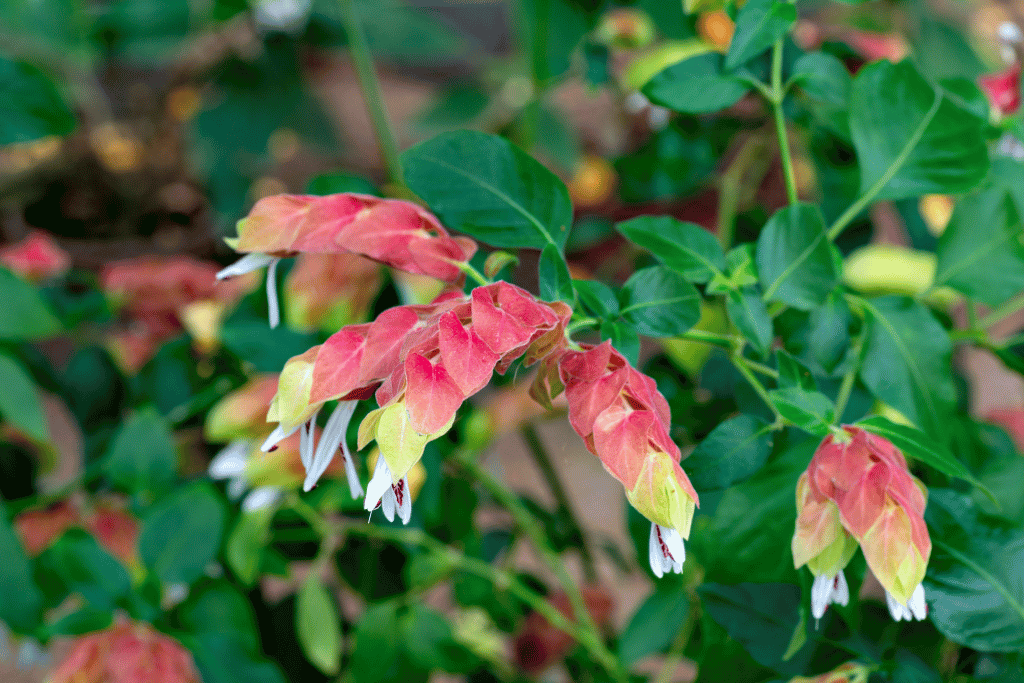
Justicia, a genus encompassing a variety of flowering plants, adds a vibrant tropical touch to gardens and landscapes. Native to tropical regions, these plants are known for their striking blooms that come in an array of colors, including shades of pink, purple, red, and white. The tubular flowers often attract pollinators like hummingbirds and butterflies.
Justicia’s versatile nature, with species ranging from shrubs to perennials, makes them valuable for creating dynamic visual compositions. Their ability to thrive in warm climates and their propensity for extended blooming periods contribute to their popularity. Justicia’s vivid presence and ability to attract wildlife remind us of the kaleidoscope of life that nature nurtures.
3. Jewel Orchid – Exquisite Intricacy in Foliage
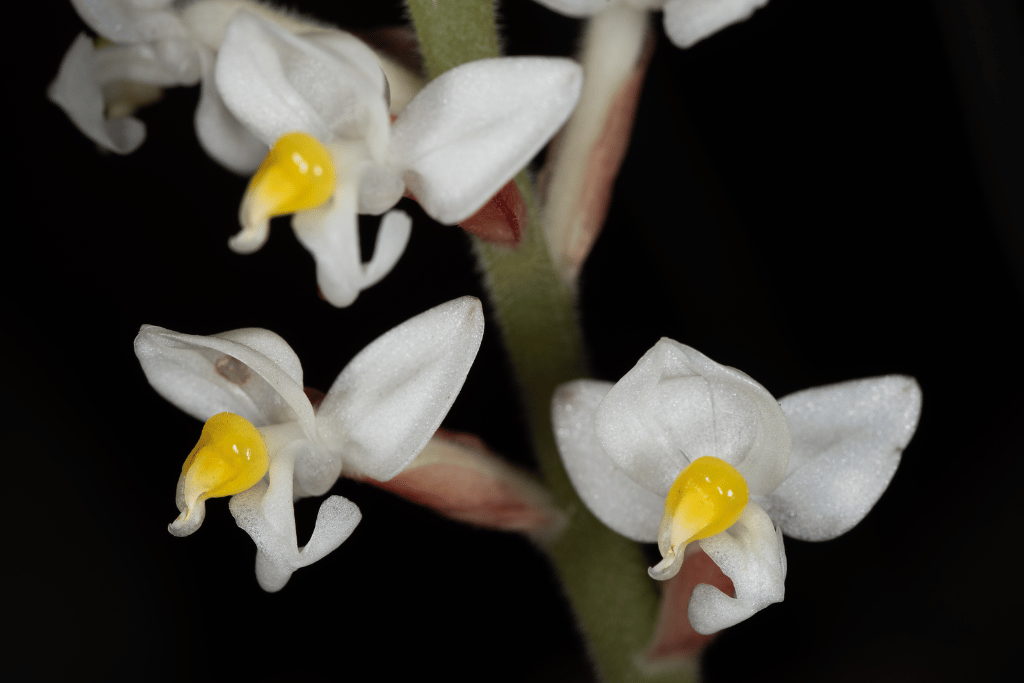
Jewel Orchid’s beauty lies not only in its blooms but in the rich tapestry of its leaves. The Jewel Orchid, scientifically labeled as Ludisia discolor, stands out as a captivating member within the orchid clan, celebrated for its intricate foliage.
Jewel Orchid’s preference for lower light levels and its ability to tolerate less humid conditions than some orchids make it a more accessible choice for indoor growing. Its foliage adds an element of elegance and mystique to orchid collections and indoor gardens.
Originating from Southeast Asia, this terrestrial orchid showcases lush leaves with patterns reminiscent of precious gemstone veins. Despite its modestly sized flowers, the real highlight is its foliage, which rightfully earns it the title of “Jewel Orchid.”
4. Jambu – Colorful Delights of the Tropics

Jambu flowers, often pale green or white, enhance the tree’s ornamental value. Native to Southeast Asia, this tree produces edible fruits with a crisp, apple-like texture and a mildly sweet flavor. Scientifically known as Syzygium samarangense, it is a tropical fruit tree showcasing vibrant blooms.
Jambu’s dual role as both a fruit-bearing tree and an ornamental plant highlights the connections between utility and beauty in the natural world. Its striking appearance and tasty fruits have made it a cherished tree in tropical gardens and orchards. Jambu’s ability to provide sustenance and delight embodies the bounty that nature generously bestows.
5. Johnny Jump-Up – Whimsical Carpet of Color
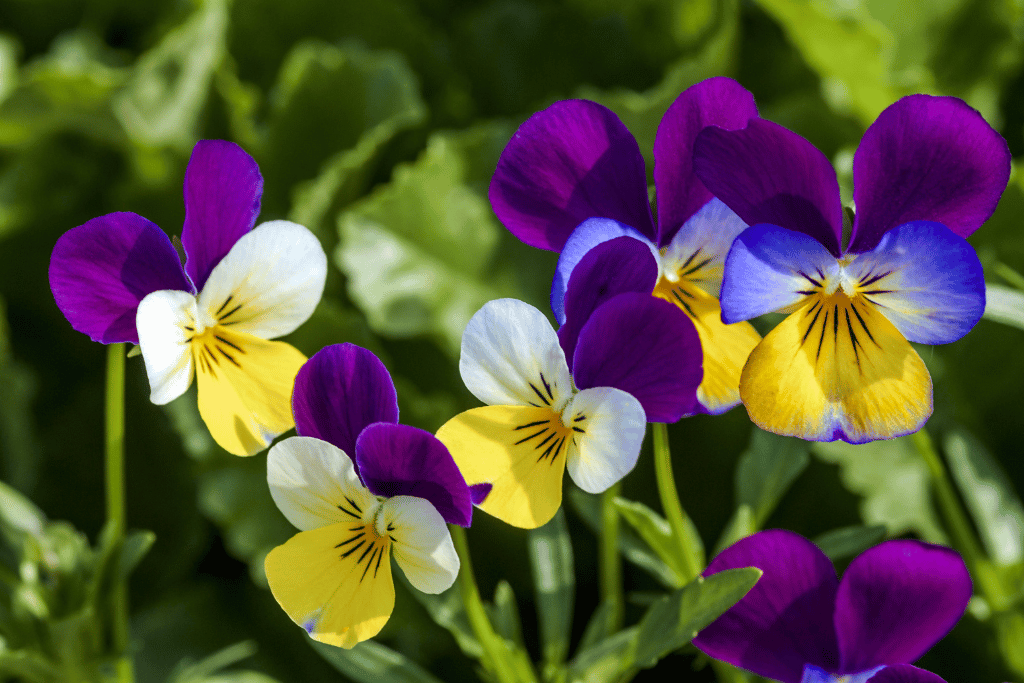
These dainty blooms not only attract pollinators but also evoke a sense of childlike wonder, reminding us of the simple joys found in nature. The flowers seem to have “jumped up” from the ground, hence the name. Johnny Jump-Up, scientifically known as Viola tricolor, is a charming wildflower that brings a playful touch to gardens. Originating in Europe, this petite yet lively plant showcases dainty purple, white and yellow flowers adorned with unique markings.
Johnny Jump-Up’s ability to self-sow and its tolerance for cooler temperatures make it a reliable choice for adding color to early spring and fall gardens.
6. Jade Vine – Exotic Cascade of Aquamarine

Jade Vine, scientifically known as Strongylodon macrobotrys, is a rare and captivating flowering vine native to the Philippines. Jade Vine’s rarity and stunning appearance have made it a sought-after choice for botanical collections and conservatories. Its pollination by bats, rather than insects, adds to its intriguing nature. Jade Vine is a testament to the astonishing diversity of plant life on our planet, offering a glimpse into the extraordinary beauty that nature can produce.
With its unique aquamarine or turquoise-colored flowers, this plant creates an otherworldly spectacle. The blooms hang in pendulous clusters, resembling cascading jewels suspended from the vine.
7. Jerusalem Artichoke – Tubers of Culinary and Visual Delight
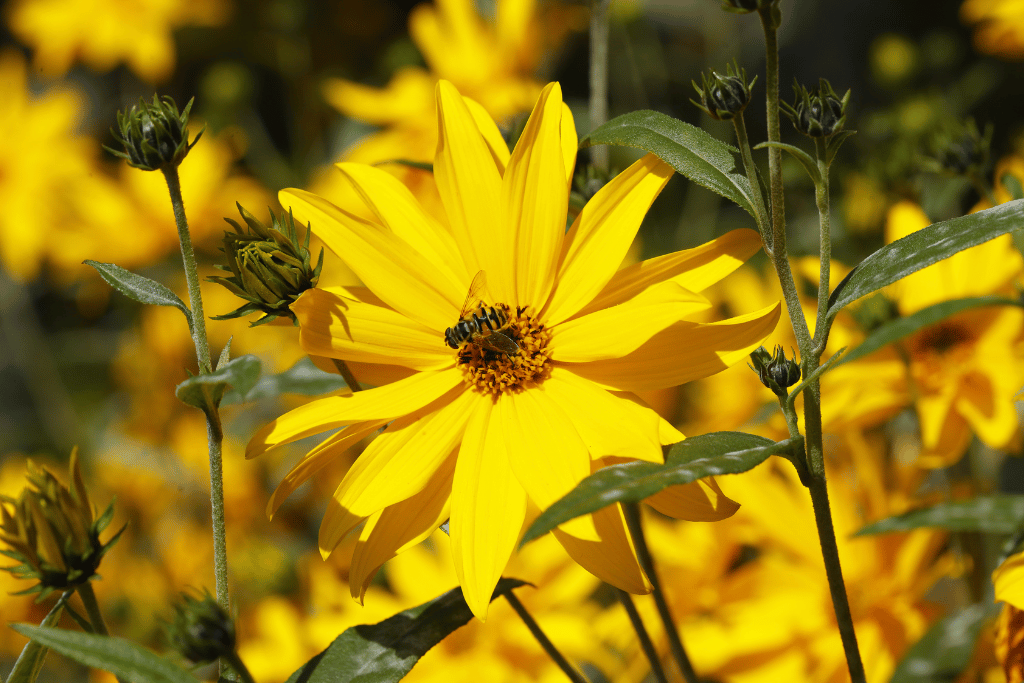
Native to North America, this perennial produces tall stems crowned with yellow, sunflower-like blooms. Jerusalem Artichoke, scientifically known as Helianthus tuberosus, is a versatile plant that offers both edible tubers and ornamental value. Despite its name, it is not related to the artichoke but is a member of the sunflower family. The plant’s edible tubers, often likened to potatoes with a nutty flavor, make it a delightful addition to culinary explorations.
Jerusalem Artichoke’s dual nature as both a tasty treat and a charming presence showcases the richness of nature’s gifts. Its sunny flowers attract pollinators and add visual appeal to gardens.
8. Joe Pye Weed – Majestic Blooms in Late Summer

Joe Pye Weed’s presence in late summer gardens brings a touch of regal beauty to the changing seasons. Joe Pye Weed, with its scientific name being Eutrochium purpureum, is a native perennial that adorns gardens with its grand presence and blossoms in shades ranging from pink to purple. Named after a Native American herbalist, this plant produces large, dome-shaped clusters of flowers that attract butterflies and other pollinators, adding life and movement to outdoor spaces.
Joe Pye Weed’s ability to thrive in moist soils and its tolerance for partial shade make it a valuable choice for wetland gardens and woodland borders. Its robust growth and pollinator-friendly nature highlight the interconnectedness of plants and wildlife.
9. Joseph’s Coat – Vibrant Foliage in a Spectrum of Hues
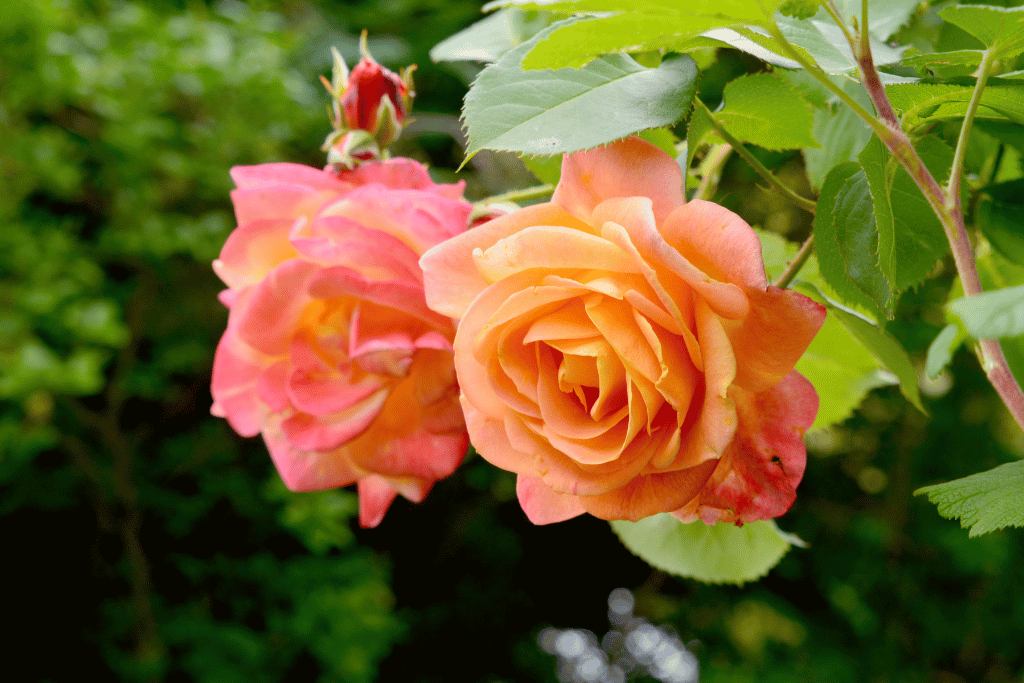
The colorful foliage of Joseph’s Coat makes it a favored choice for ornamental arrangements and container gardening. Its ability to thrive in full sun to partial shade and its versatility in design make it a valuable addition to landscapes seeking bold visual impact.
Joseph’s Coat, scientifically labeled as Alternanthera ficoidea, is a tropical flora renowned for its vividly hued leaves spanning the spectrum from reds and oranges to yellows and greens. Originating in the Americas, this plant, in its annual or perennial form, injects a lively burst of color into gardens and outdoor settings.
Joseph’s Coat’s kaleidoscope of colors reflects the exuberance of nature’s palette and the infinite variations it can create.
10. Jonquil – Harbingers of Spring’s Radiant Arrival
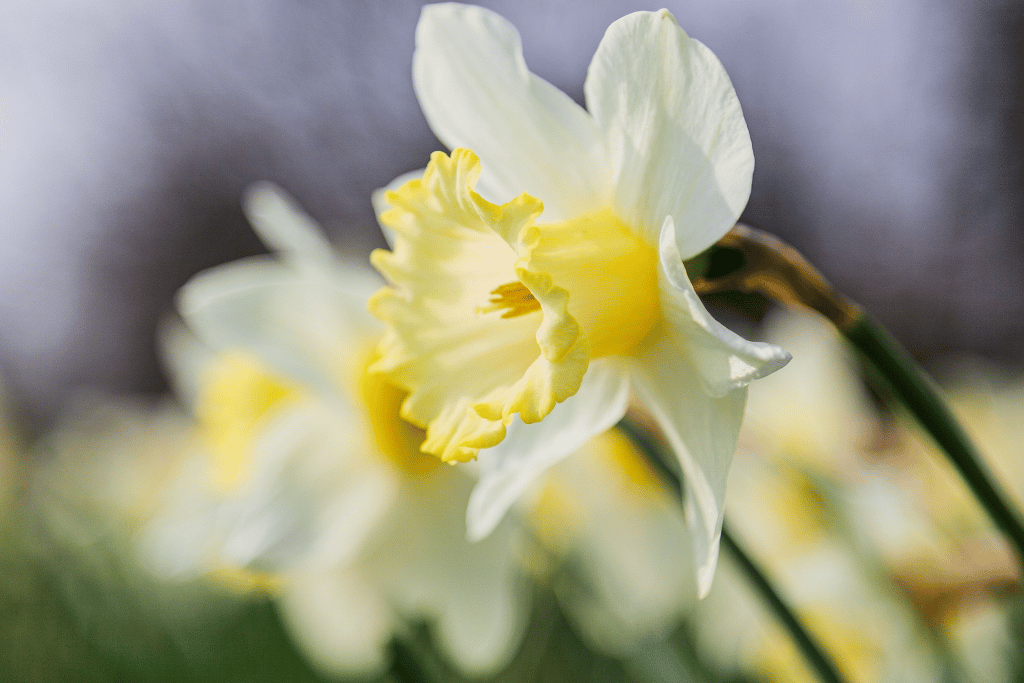
Jonquils’ delicate blossoms remind us that the changing seasons bring with them renewal and the promise of beauty. The blooms come in shades of yellow and white. Jonquil, scientifically known as Narcissus jonquilla, is a fragrant flowering bulb that heralds the arrival of spring with its charming blossoms. Native to Spain and Portugal, this plant produces clusters of small, trumpet-shaped flowers that emit a sweet fragrance.
Jonquils’ cheerful appearance and their early bloom time make them a cherished harbinger of the warmer seasons. Their ability to naturalize and their resilience in a variety of conditions have made them a popular choice for both formal and informal garden designs.
11. Jack-in-the-Pulpit – Enigmatic Beauty of Woodlands
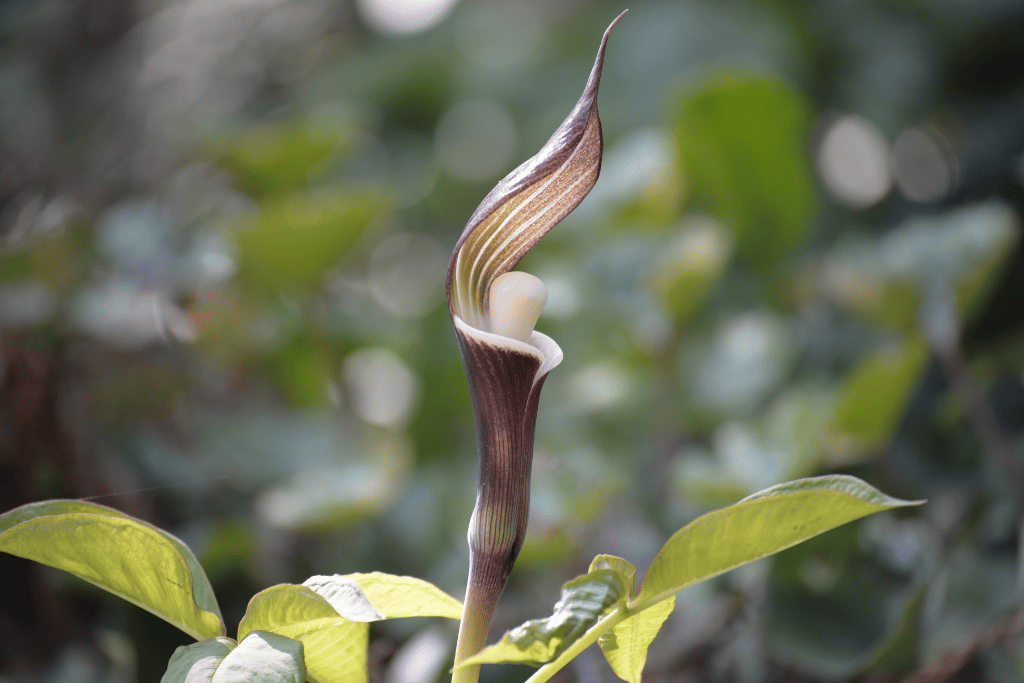
The “Jack” represents the inconspicuous flower hidden within, while the “pulpit” is formed by the surrounding hood. Botanically, jack-in-the-Pulpit’ known as Arisaema triphyllum, is a fascinating wildflower native to North American woodlands. Its unique inflorescence resembles a small figure sheltered within a pulpit-like structure, hence the name.
This plant’s distinctive appearance and intriguing reproductive mechanism have earned it a special place among nature enthusiasts. Jack-in-the-Pulpit’s green and maroon coloration adds a touch of mystery to shaded forest floors. As the plant matures, it produces clusters of bright red berries, contributing to its role in supporting local wildlife.
12. Japanese Anemone – Elegance in Autumn Blooms

Japanese Anemones’ ability to thrive in partial shade and their resistance to deer make them popular choices for woodland gardens and shaded borders. These flowers symbolize anticipation and unfurling, reminding us of the quiet beauty that can be found in the changing seasons.
Japanese Anemone, known scientifically as Anemone × hybrida, graces gardens with its graceful presence and late-season blooms. Native to China and Japan, this perennial beauty stands out with its delicate, cup-shaped flowers that come in shades of white, pink, and mauve. Their appearance coincides with the transition from summer to fall, adding a touch of elegance to the autumn landscape.
13. Jacob’s Ladder – Whimsical Staircase of Blooms

Botanically, Jacob’s Ladders are called Polemonium caeruleum, enchants with unique clusters of bell-shaped flowers arranged in a ladder-like pattern. Native to Europe and Asia, this perennial features fern-like foliage that adds to its enchanting appearance. The blossoms come in shades of blue, pink, and white.
Jacob’s Ladder’s whimsical name is inspired by the arrangement of its leaflets, which resemble the rungs of a ladder. Its delicate yet robust nature makes it a valuable addition to woodland gardens, where it brings a touch of charm to shaded areas. The blooms evoke a sense of climbing upward, symbolizing growth and aspiration.
14. Jasmine – Aromatic Elegance and Cultural Symbol
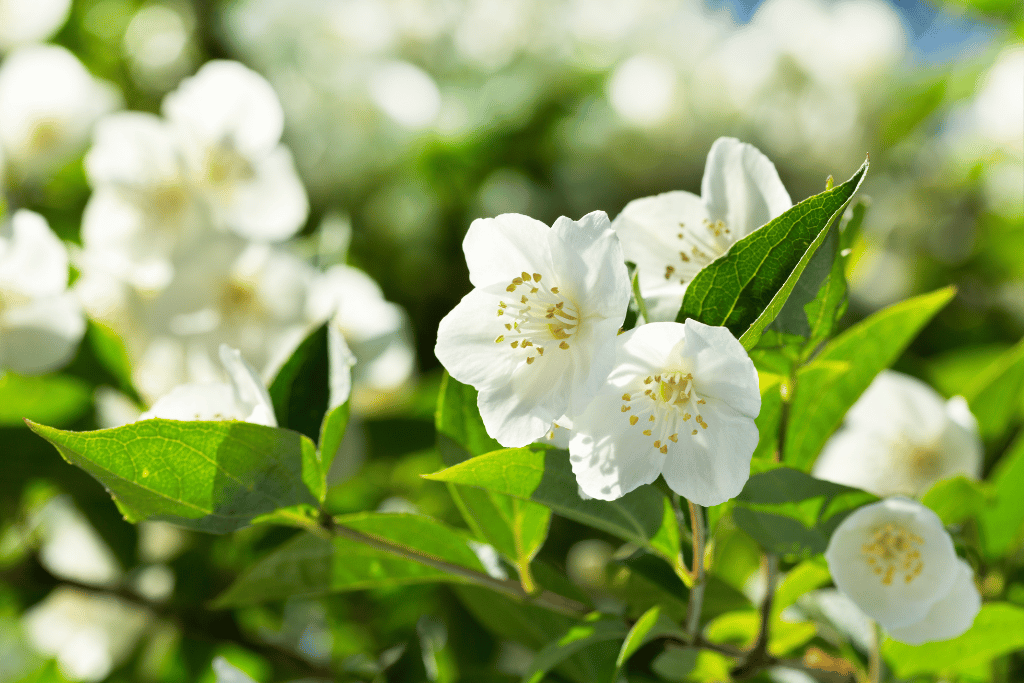
Jasmine, a genus encompassing a variety of fragrant flowering plants, adds a touch of exotic allure to gardens and landscapes. Originating in tropical and subtropical areas, Jasmines are renowned for their captivating scent and fragile flowers. The white flowers, resembling stars and occasionally tinged with a touch of pink or yellow, establish an atmosphere of romantic sophistication.
Jasmine’s significance extends beyond its visual and olfactory appeal. In many cultures, it is revered for its symbolic meaning, representing purity, love, and beauty. Whether climbing along trellises, adorning arbors, or gracing containers, Jasmines offer a sensory journey that transports observers to distant lands and timeless traditions.
15. Japanese Camellia – Elegance in Winter Blooms

Japanese Camellias stand as enduring symbols of beauty even amid adversity. These rose-like beauties are called Camellia japonica, a cherished flowering shrub native to East Asia. Renowned for its captivating blooms that appear during the colder months, this evergreen beauty adds a touch of elegance to winter landscapes. The flowers, often in shades of white, pink, and red, create a striking contrast against the dark foliage.
Japanese Camellias’ ability to thrive in partial shade and their resilience in colder climates make them valuable additions to gardens. Their historical significance in various cultures and their association with longevity and admiration further enhance their appeal.
16. Jerusalem Sage – Sage Green Elegance
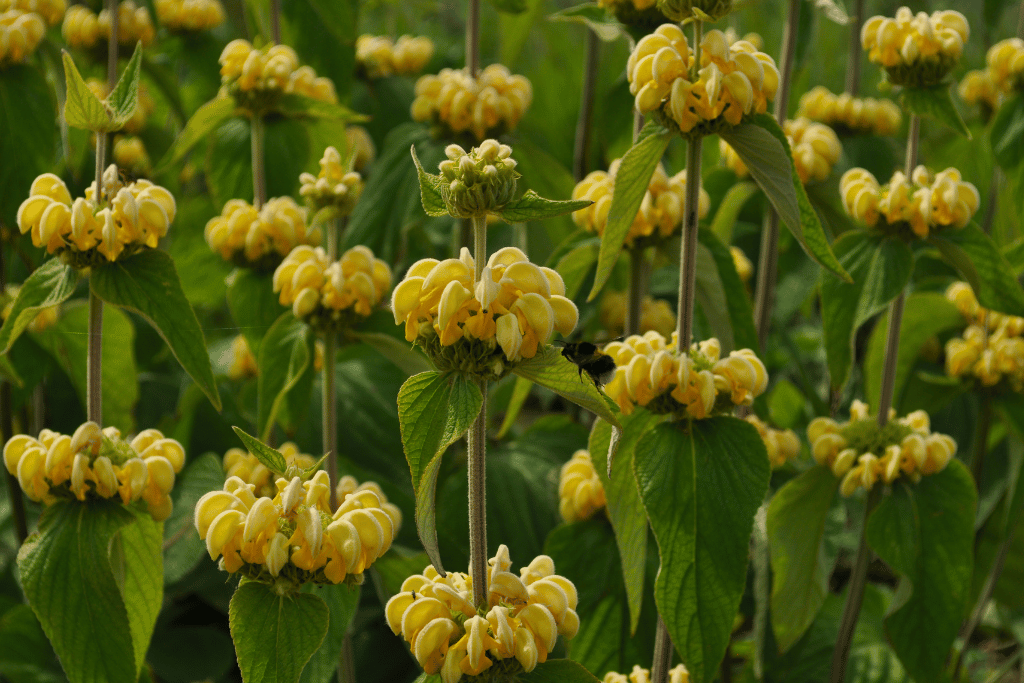
Jerusalem Sage, scientifically known as Phlomis fruticosa, brings a unique and rustic charm to gardens. Native to the Mediterranean region, this perennial shrub is recognized for its whorls of sage green leaves and distinctive clusters of yellow flowers. The blooms are surrounded by a papery bract that adds to the plant’s visual interest.
Jerusalem Sage’s drought tolerance and preference for well-drained soil make it suitable for Mediterranean-inspired landscapes and dry gardens. Its architectural form and muted color palette contribute to a sense of tranquility, evoking the timeless beauty of arid landscapes.
17. Jupiter’s Beard – Vivid Accents of Summer
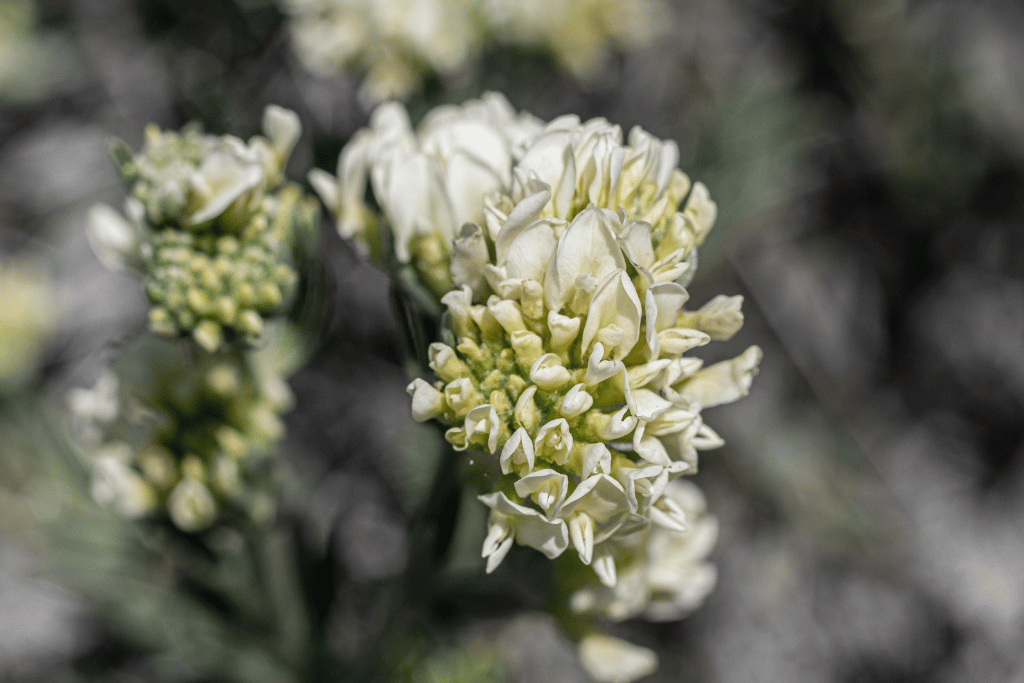
Jupiter’s Beard, scientifically referred to as Centranthus ruber, is a perennial herbaceous plant that adds a burst of color to summer gardens. Originating from the Mediterranean area, this plant showcases bunches of cylindrical blooms that appear in red, pink, and white hues. These flowers allure an array of pollinators, establishing their importance as valuable participants within garden ecosystems.
Jupiter’s Beard’s ability to thrive in various soil types, including poor and rocky soils, makes it a resilient choice for challenging garden conditions. Its graceful form and vivid hues create an exuberant atmosphere that marks the height of summer’s vibrancy.
18. Japanese Quince – Splash of Early Spring Color

Native to East Asia, this plant features vivid flowers that range from deep reds and oranges to delicate pinks. The flowers appear before the leaves, creating a striking contrast against the bare branches. Japanese Quince, scientifically known as Chaenomeles japonica, is a deciduous shrub that heralds the arrival of spring with its vibrant blossoms.
Japanese Quince’s thorny branches make it an effective choice for creating natural barriers and hedges. Its adaptability to different soil types and its ability to thrive in both sun and partial shade make it a versatile addition to gardens.
The early burst of color from Japanese Quince is a visual reminder that nature’s beauty has the power to awaken even the dormant landscapes of early spring.
19. Jasmine Tobacco – Fragrance in Sunset Hues

Jasmine Tobacco’s ability to attract moths for pollination adds to its intrigue, as these evening visitors contribute to its reproductive success. The plant’s delicate beauty and its scent wafting through the twilight air create a serene ambiance in outdoor spaces, transforming gardens into enchanting havens.
Jasmine Tobacco, scientifically known as Nicotiana alata, offers both visual and olfactory delights to garden enthusiasts. Native to South America, this annual plant features trumpet-shaped flowers that open in the late afternoon and emit a sweet fragrance that lingers into the evening. The blossoms range in color from white to shades of pink and lavender.
20. Judas Tree – Springtime Spectacle in Pink
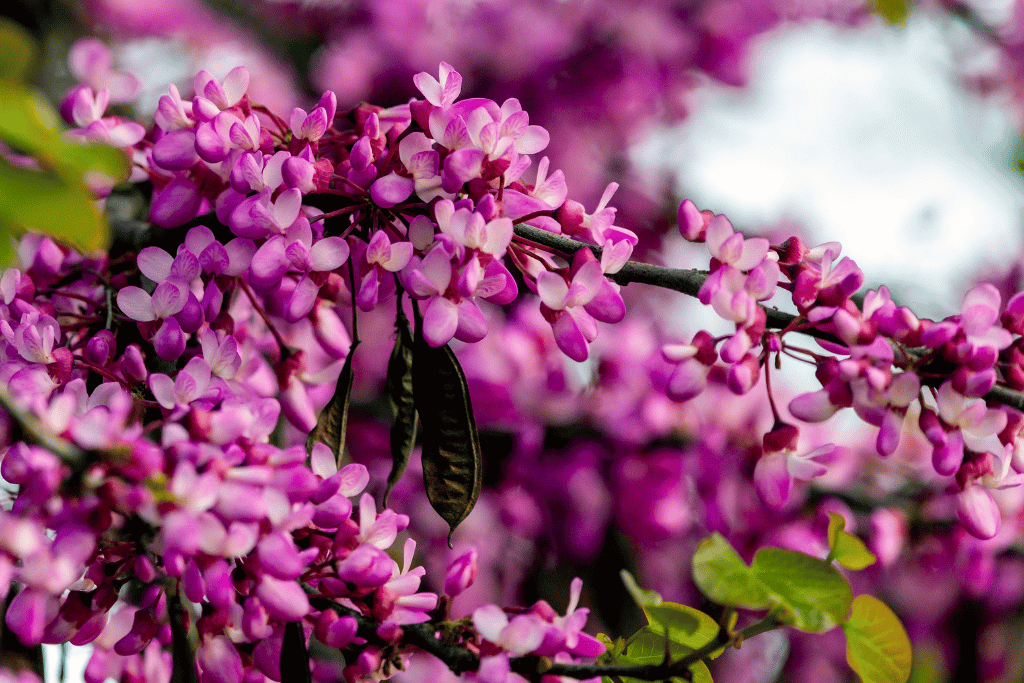
Judas Tree’s ability to thrive in warmer climates and its adaptability to various soil types make it a favored choice for ornamental landscapes. Its arrival heralds the arrival of spring’s color, and its rosy blooms create a picturesque scene against the backdrop of emerging greenery. Judas Tree, scientifically known as Cercis siliquastrum, is a deciduous tree that creates a stunning display of pink blossoms in the spring.
Originating from the Mediterranean area, this tree’s distinctive moniker is thought to have originated from the notion that Judas Iscariot met his end by hanging from a tree belonging to this variety. Its vibrant flowers cover the branches before the heart-shaped leaves emerge.
21. Japanese Andromeda – Elegance in All Seasons

This shrub’s enduring appeal showcases the importance of diversity in garden design. Its changing foliage hues add depth and dimension to landscapes, while its elegant blooms provide a seasonal focal point. Japanese Andromeda, known scientifically as Pieris japonica, is an evergreen shrub that offers year-round beauty. Native to Eastern Asia, this plant boasts leathery foliage that varies in color, from deep green to shades of red and bronze.
Japanese Andromeda’s adaptability to different light conditions and its preference for acidic soil make it suitable for various garden styles. The clusters of pendulous white or pink flowers appear in early spring, creating a striking contrast against the leaves.
22. Jacob’s Pillow – Whimsical Blooms of Summer
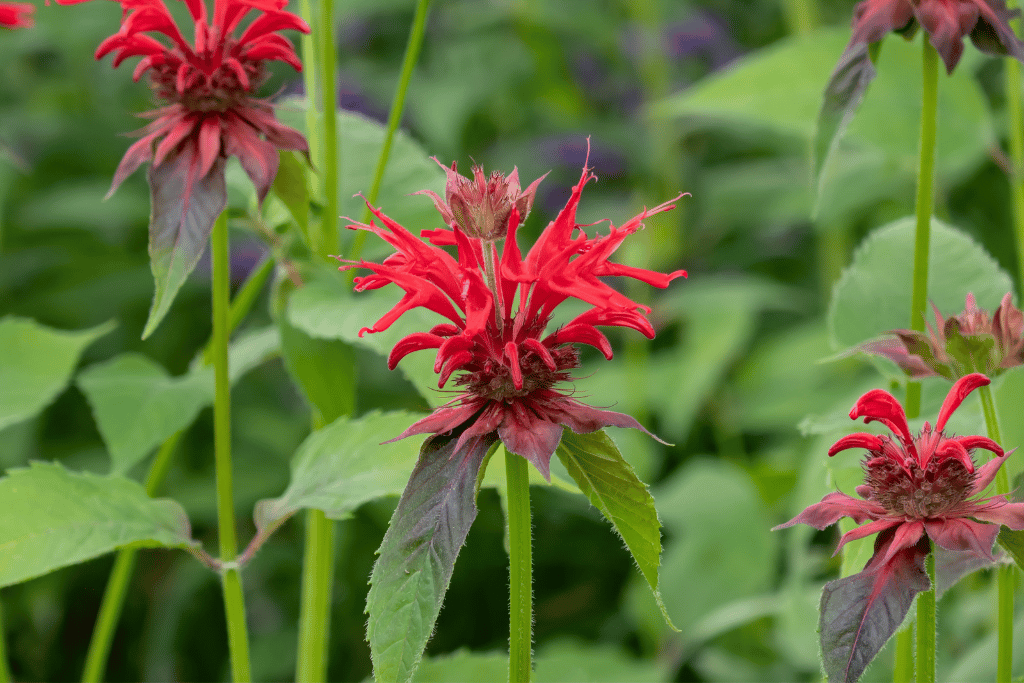
Jacob’s Pillow, botanically known as Monarda ‘Jacob Cline,’ is a perennial plant that adds a touch of whimsy to gardens with its vibrant and intricate blooms. Native to North America, this plant’s tubular flowers form dense clusters in shades of scarlet red. The flower’s appearance, resembling small pillows, lends to its endearing name. Jacob’s Pillow’s ability to attract pollinators like bees and butterflies and its resistance to deer make it valuable for supporting local ecosystems.
Its striking appearance contributes to the visual tapestry of summer landscapes, while its ecological role emphasizes the interconnectedness of all living things.
23. Japanese Wisteria – Cascading Elegance in Spring
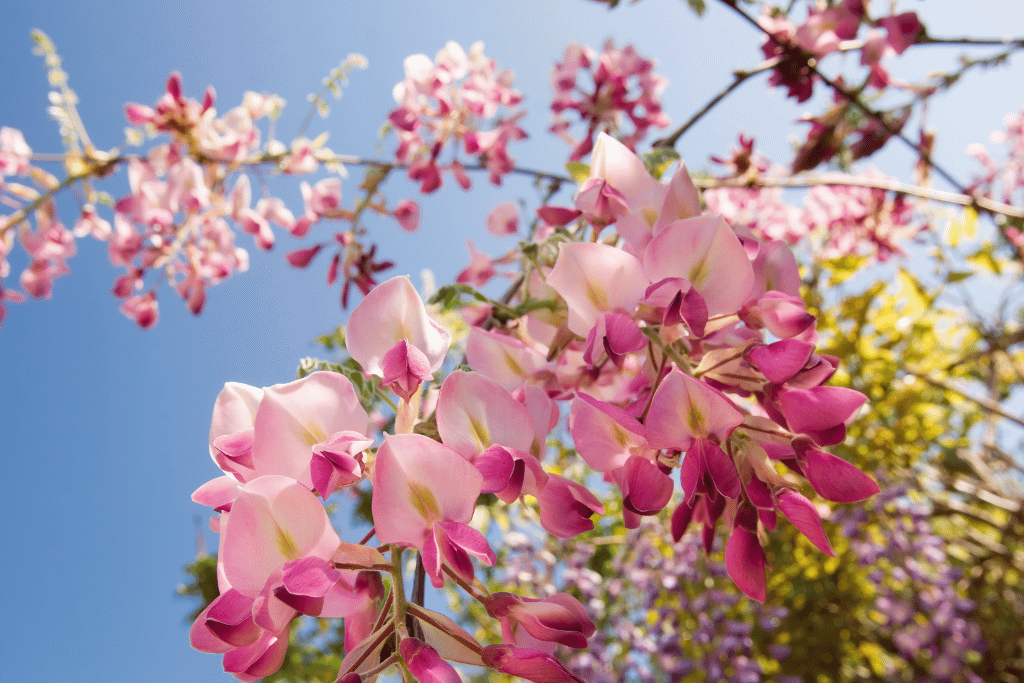
Japanese Wisteria’s ability to climb arbors, pergolas, and trellises makes it a favored choice for creating living archways and shaded spaces. Native to Japan, this vine is celebrated for its dramatic and romantic appearance. The pendulous blooms, which can be shades of blue, purple, pink, or white, create an enchanting spectacle in the spring.
Its graceful form and fragrant blossoms evoke a sense of nostalgia and lend an air of elegance to garden landscapes. Japanese Wisteria, scientifically known as Wisteria floribunda, is a breathtaking vine that enchants with its cascading clusters of fragrant flowers.
24. Jaboticaba – Unique Beauty of Fruit and Flower

Jaboticaba’s distinctive growth habit and the visual contrast between its flowers and fruits make it a remarkable addition to tropical and subtropical gardens. Its ability to bear fruit on its bark reflects nature’s endless capacity for innovation and adaptation.
Jaboticaba, scientifically known as Myrciaria cauliflora, is a tropical tree that captures attention with its unique habit of flowering directly on its trunk and branches. It is native to Brazil, and this tree produces small, grape-like fruits and white, star-shaped flowers that emerge from the bark. The fruit’s sweet and tangy flavor makes it a popular treat.
25. Juniper – Evergreen Resilience and Fragrance
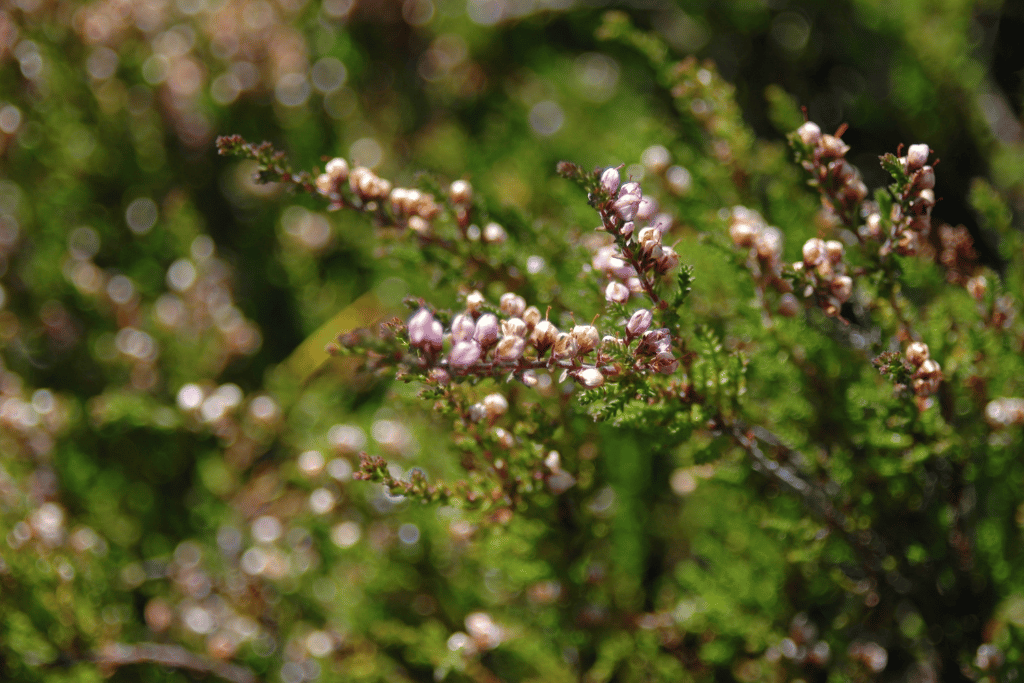
Juniper, a diverse group of evergreen shrubs and trees, offers a range of forms and sizes that contribute to garden landscapes. With species native to various parts of the world, junipers are known for their needle-like foliage and distinctive cones. Some species emit a pleasant fragrance when brushed against.
Junipers’ adaptability to different soil types and their ability to thrive in a variety of climates make them valuable additions to gardens and landscapes. From ground covers to towering specimens, junipers symbolize enduring strength and the capacity to weather the changing seasons.



